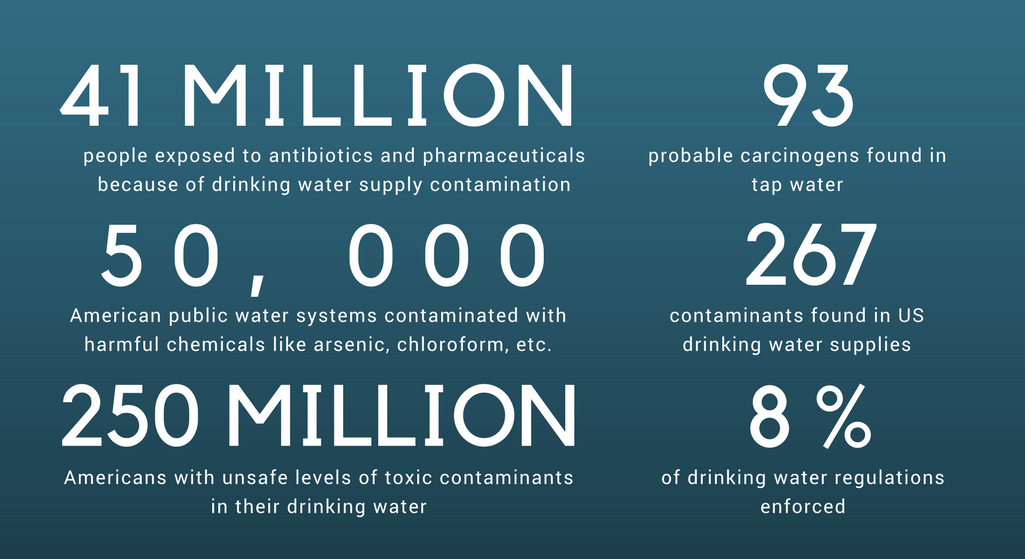Posted by Dr. Roy M. Speiser on Feb 26th 2018
The Myth of Clean Water
With chronic illness on the rise, people are desperately trying to stem the onslaught, all the while drinking and bathing in the most damaging problem of all.

The notion of safe drinking water is a myth. The fact that your tap water gets a passing grade from the EPA doesn’t mean it’s safe— in fact, far from it.
Our drinking water has become a repository for toxic waste. Agricultural run-off is flushing heavy metals, pesticides, herbicides, and chemical fertilizers into the environment which then seep into our water supply. Industry illegally dumps chemicals into the ground and waterways. The scope of the problem is staggering. For example, in 2016, 62,458 pounds of glyphosate (Roundup) was used on dairy farms in the state of Vermont alone—more than double the amount used in 2014.
New emerging contaminants have also made their way into our water supply, such as PFOA (from Teflon); flame-retardant chemicals; industrial agents such as PFOS, 1,4-dioxane, MTBE, and perchlorate. Dumping by hospitals and pharmaceutical companies sends countless drugs into the environment that are making their way into our drinking water.

The following statistics are disturbing:
- More than 250 million Americans are drinking water with unsafe levels of various toxic contaminants.
- Based on research conducted between 2010 and 2015, the Environmental Working Group (EWG) found nearly 50,000 American public water systems contaminated with hundreds of harmful chemicals, including arsenic, hexavalent chromium, radiation, chloroform, PFOA, and others. Of the approximately 500 contaminants tested, they detected a whopping 267 in US drinking water supplies.
- An ongoing Associated Press investigation detected 46 different pharmaceuticals in the US drinking water supply, exposing more than 41 million people to antibiotics, anticonvulsants, antidepressants, anticoagulants, sex hormones, and the list goes on.
- The nation’s tap water includes 93 known or probable carcinogens that exceed established regulatory health guidelines—levels that pose minimal but real health risks but are not legally enforceable.
- It’s been 20 years since the EPA last passed any new drinking water regulations, and only a meager 8 percent of violations are enforced. In terms of water quality, the US is approaching “Third World” conditions.
Click here for EWG’s Interactive map to see what’s lurking in your local water supply.
Water Contaminants 101
The list of contaminants found in drinking water is far too extensive to cover here, but I will elaborate on three that are particularly problematic: Disinfection byproducts, fluoride, and hexavalent chromium.

Chlorine, Chloramines, and Disinfection Byproducts (DBPs)
Water chlorination dates back to the late 1800s when it was instigated to guard against harmful microorganisms such as typhoid, cholera, giardiasis, and hepatitis. We have since learned of chlorine’s unfortunate side effect of reacting with naturally occurring organic matter in the water to form disinfection byproducts. DBPs are extremely toxic—more than 1,000 times as toxic as chlorine.
The regulated DBPs include two groups: trihalomethanes (THMs) and haloacetic acids (HAAs), which include bromate, and chlorite. Both THMs and HAAs have carcinogenic effects, but the evidence is strongest against THMs, particularly chloroform. This has led to the EPA classifying THMs as Class B “probable carcinogens.”
Even at lower levels, human studies point to associations between THMs and reproductive problems (congenital malformations, stillbirths and miscarriages); heart, lung, liver, and kidney damage; and an increased risk of bladder and colorectal cancer. Haloacetic acids (HAAs) have been linked to liver disease, neurological problems, cancer, and reproductive abnormalities.
At around 100 degrees F. chlorine becomes a gas, so you are inhaling THMs while at the same time absorbing it through your skin. People don’t realize that 15 to 20 percent of their daily chlorine intake comes from showering or bathing.
Fluoride, Bad News for Your Brain
Fluoride is a neurotoxin. Despite a mountain of evidence about its health-destroying effects, about 75 percent of the US population still receives fluoridated water.
The evidence about fluoride’s toxicity is extensive. Perhaps most disturbing is that babies exposed to fluoridated water in-utero via the mother show grossly abnormal brain development. These mothers drank fluoridated water that was within “safe guidelines” as set by the EPA—the same water we drink today. A recent study involving Mexican women found that children with prenatal fluoride exposure have lower IQs.
Hexavalent Chromium (Chromium-6), the “Erin Brokovich” Chemical
Hexavalent chromium—a byproduct of steel and pulp mills, metal-plating, and leather-tanning operations—is notorious for causing gastrointestinal cancers. The EWG testing found it in 31 of 35 tap water samples from cities across the US. The report estimated that, if left untreated, hexavalent chromium in tap water will cause more than 12,000 new cases of cancer.
The Cumulative Effect of 93 Carcinogens is Terrifying
Any one of the above contaminants would be cause enough for concern, but the greater problem is cumulative toxicity. With the EWG’s finding 267 different chemicals in the nation’s water supply, it’s clear people are not being exposed to just one chemical at a time.
The limited science to date confirms that chemical mixtures often have dose-additive effects in the human body. For example, combinations of endocrine disrupting chemicals (EDCs), such as phthalates and pesticides are able to produce significant effects, even when each chemical is present at a low enough dose to not individually produce a measurable effect.
The Solution Requires Thinking Outside the Tank
In an attempt to filter out these toxins from their water, millions of consumers are buying filters that are entry-level, or minimal, filters such as pour-through pitchers or faucet filters. These devices are not capable of removing the wide array of contaminants found in today’s drinking water. They may reduce small amounts of chlorine, lead, bad taste and odor, but when it comes to fluoride, parasites, heavy metals, chloramine, pharmaceuticals, and industrial chemicals, they are simply not up to the task.
The best protection requires a multi-barrier filtration system that can effectively eliminate even the smallest particles from your water. When it comes to water filters, there is no one-size-fits-all. Different contaminants require different filtration technologies. For example, THMs and pharmaceuticals are best removed by special carbons. Reverse osmosis is good for metals but not effective for industrial chemicals. Ceramics are best for parasites, which chlorine does not kill.
The most effective system includes a filtration tank located on the home main pipe containing different filtration materials to remove industrial chemicals, chlorine, DBPs, and start the process of removing heavy metals. If your water evaluation detects special contaminants, specialized filters can be added.
The next step in the treatment chain is to add filtration at the sink, which removes contaminants such as fluoride, bacteria, parasites and heavy metals. An effective multistage system should reduce enough contaminants that by the time your water reaches the tap, the chemicals and heavy metals are essentially non-detectable.
When it comes to choosing a system, my advice is to purchase the best filter you can afford with the latest filtration technology for handling the more challenging contaminants, including fluoride. A new effective technology is MetalgonTM, which utilizes a combination of ceramic pre-filtration, activated carbon plus other superior adsorbent materials, melded into a solid block with a dense, high-performance pore structure.
About the Author:

Dr. Speiser has advanced degrees in biology, biochemistry, bacteriology, certifications in biomechanical engineering, water specialist and over 30 years combined experience as a research scientist and holistic healthcare practitioner.
For more information, please contact:
Dr. Roy M. Speiser, Vice President
Clean Water Revival, Inc. dba CWR Environmental Products
DrSpeiser@cwrenviro.com
www.cwrenviro.com
Ph: 800-444-3563
4 S Richardson, et al. “Occurrence, genotoxicity, and carcinogenicity of regulated and emerging disinfection by-products in drinking water, Mutation Research/Reviews in Mutation Research 2007:636(1-3); pp.178-242, doi:10.1016/j.mrrev.2007.09.001
“National Primary Drinking Water Regulations,” EPA, https://www.epa.gov/ground-water-and-drinking-water/national-primary-drinking-water-regulations
“National Primary Drinking Water Regulations: Stage 2 Disinfectants and Disinfection Byproducts Rule.” Federal Register, 4 Jan. 2006, www.federalregister.gov/documents/2006/01/04/06-3/national-primary-drinking-water-regulations-stage-2-disinfectants-and-disinfection-byproducts-rule
“Water Fluoridation Basics,” CDC, Community Water Fluoridation https://www.cdc.gov/fluoridation/basics/index.htm, accessed February 8, 2018
Fluoride Action Network, www.fluoridealert.org
M Connett, “Fluoride’s effect on fetal brain,” FlourideAlert.org, April 2015, accessed February 8, 2018
“Fluoride exposure in utero linked to lower IQ in kids, new study says,” FlourideAlert.org, September 19, 2017, accessed February 8, 2018
D Andrews and B Walker, “’Erin Brokovich’ carcinogen in tap water of more than 200 million Americans,” EWG, September 20, 2016, accessed February 8, 2018
N Hadrup, “Evidence from pharmacology and pathophysiology suggests that chemicals with dissimilar mechanisms of action could be of bigger concern in the toxicological risk assessment of chemical mixtures than chemicals with a similar mechanism of action,” Regulatory Toxicology and Pharmacology August 2014;69(3):281-283, https://doi.org/10.1016/j.yrtph.2014.05.007, accessed February 8, 2018
DO Carpenter, K Arcaro, and DC Spink,”Understanding the human health effects of chemical mixtures,” Environmental Health Perspectives 2002;110(Suppl 1):25-42, https://www.ncbi.nlm.nih.gov/pmc/articles/PMC1241145/, accessed February 8, 2018
A Kortenkamp, “Ten Years of Mixing Cocktails: A Review of Combination Effects of Endocrine-Disrupting Chemicals,” Environmental Health Perspectives 2007;115(Suppl 1):98-105, doi:10.1289/ehp.9357, accessed February 8, 2018

